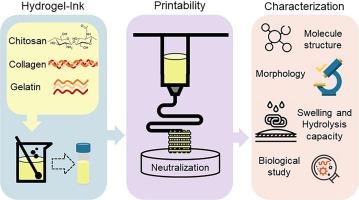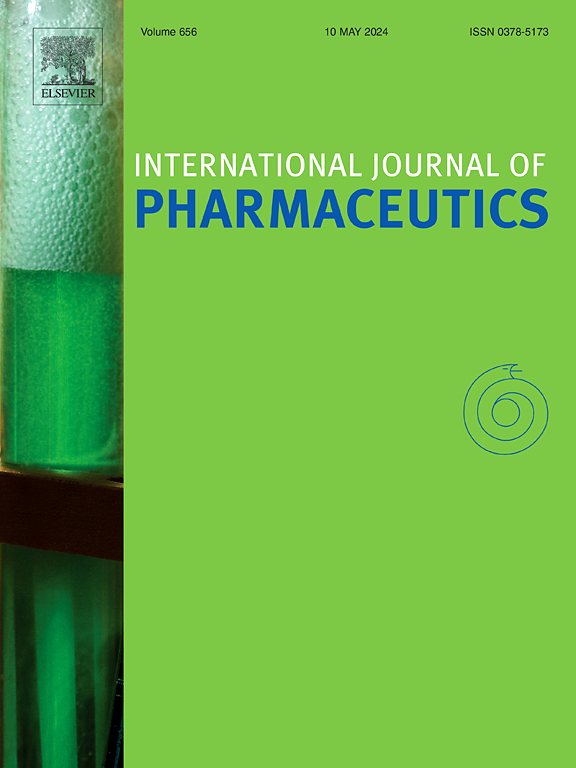Optimization of chitosan-gelatin-based 3D-printed scaffolds for tissue engineering and drug delivery applications
IF 5.3
2区 医学
Q1 PHARMACOLOGY & PHARMACY
引用次数: 0
Abstract
The combination of biocompatible materials and advanced three-dimensional (3D) additive manufacturing technologies holds great potential in the development of finely tuned complex scaffolds with reproducible macro- and micro-structural characteristics for biomedical applications, such as tissue engineering and drug delivery. In this study, biocompatible printable inks based on chitosan, collagen and gelatin were developed and 3D-printed with a pneumatic-based extrusion printer. The printability of various chitosan–gelatin (CS-Gel) hydrogel inks was assessed by evaluating the quality of the printed constructs. The inks required an extrusion pressure of 150 ± 40 MPa with G22 and G25 nozzles for optimal printing. Inks with low chitosan concentrations (<4% w/v) exhibited poor printability, while inks with 4 % w/v chitosan and 1 % w/v gelatin (CG) demonstrated satisfactory extrusion and printing quality. The addition of collagen (0.1 % w/v) to the optimized ink (CGC) did not compromise printability. Post-printing stabilization using KOH produced self-supporting scaffolds with consistent morphological integrity, while weaker bases like NaOH/EtOH and ammonia vapors resulted in lower pore sizes and reduced structural stability. Water evaporation studies showed that neutralized samples had slower evaporation rates due to the strong intermolecular interactions formed during the neutralization process, contributing to a stable crosslinked network. FTIR spectra confirmed the formation of polyelectrolyte complexes in the CS-Gel and CS-Gel-Collagen blends, further enhancing structural stability. Swelling tests indicated that neutralized constructs maintained stability in different pH environments, with KOH-treated samples exhibiting the lowest swelling ratios and the highest structural stability. After optimizing the ink composition, 10 wt% Levofloxacin was loaded in the constructs as a model antibiotic and it’s in vitro release rate was quantified. Drug loading was approximately 4 % for both ink compositions GC and CGC. CG Levo released over 80 % of levofloxacin within the first hour, reaching full release in 24 h, indicating inadequate control, while CGK Levo exhibited slower initial release (55 % in 15 min) followed by stabilized release after 4 h, likely due to controlled diffusion from expanded constructs. These findings demonstrate that the developed hydrogel inks and optimized printing parameters can produce scaffolds suitable for tissue engineering applications. Finally, the cell compatibility of the 3D-printed constructs was confirmed with MTT assay on fibroblasts and the antimicrobial activity of the drug-loaded constructs was tested against E. coli and S. aureus, showing an increase of the bacteria free zone from 8 ± 0.4 mm of the control against E. coli up to 16.4 ± 0.37 mm in the presence of the KOH-treated CG Levo printed construct.

基于壳聚糖-明胶的三维打印支架在组织工程和药物输送应用中的优化。
生物相容性材料与先进的三维(3D)增材制造技术相结合,在为组织工程和药物输送等生物医学应用开发具有可重现宏观和微观结构特征的微调复杂支架方面具有巨大潜力。本研究开发了基于壳聚糖、胶原蛋白和明胶的生物相容性可打印油墨,并使用气动挤出式打印机进行了三维打印。通过评估打印结构的质量,对各种壳聚糖-明胶(CS-Gel)水凝胶油墨的可打印性进行了评估。这些油墨需要 150 ± 40 兆帕的挤出压力和 G22 和 G25 喷嘴才能达到最佳打印效果。壳聚糖浓度较低的油墨 (
本文章由计算机程序翻译,如有差异,请以英文原文为准。
求助全文
约1分钟内获得全文
求助全文
来源期刊
CiteScore
10.70
自引率
8.60%
发文量
951
审稿时长
72 days
期刊介绍:
The International Journal of Pharmaceutics is the third most cited journal in the "Pharmacy & Pharmacology" category out of 366 journals, being the true home for pharmaceutical scientists concerned with the physical, chemical and biological properties of devices and delivery systems for drugs, vaccines and biologicals, including their design, manufacture and evaluation. This includes evaluation of the properties of drugs, excipients such as surfactants and polymers and novel materials. The journal has special sections on pharmaceutical nanotechnology and personalized medicines, and publishes research papers, reviews, commentaries and letters to the editor as well as special issues.

 求助内容:
求助内容: 应助结果提醒方式:
应助结果提醒方式:


